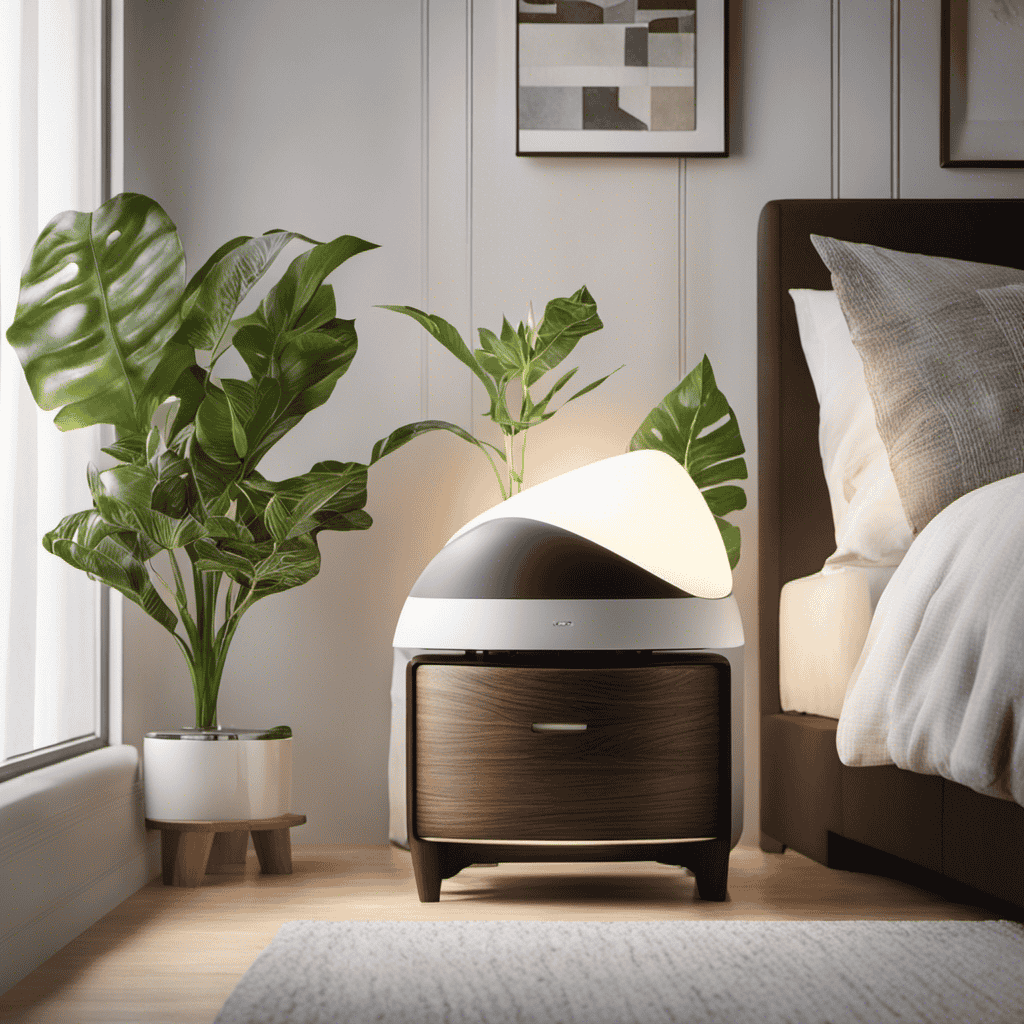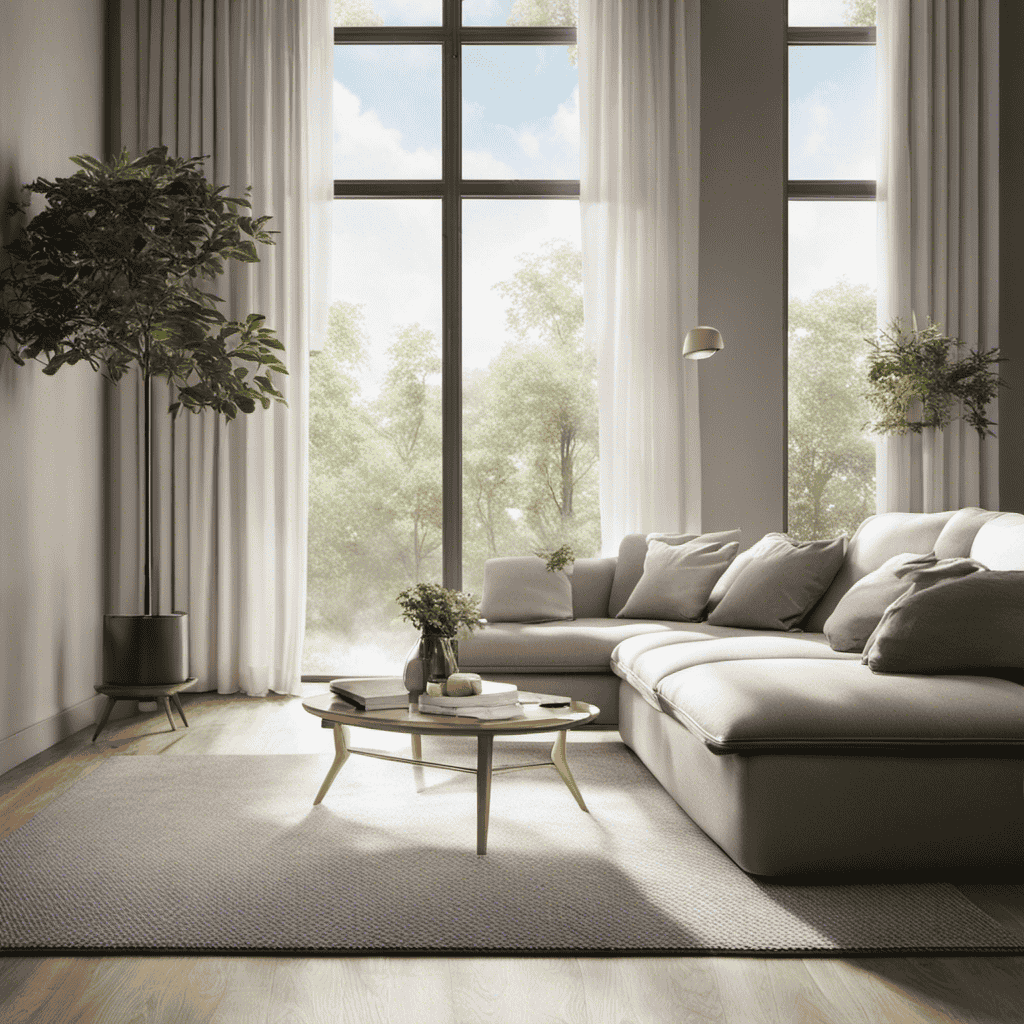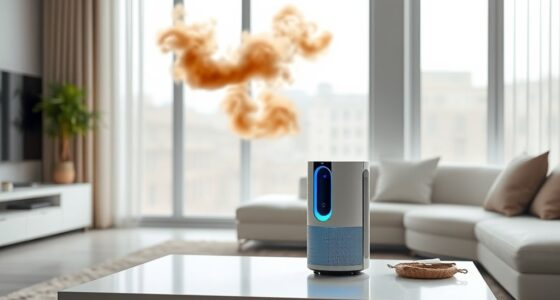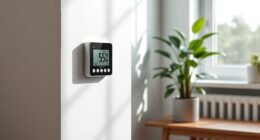So, you’re interested in learning more about what a humidifier and air purifier are, right? Let me explain it to you.
These nifty gadgets are like the dynamic duo of indoor air quality. Humidifiers add moisture to the air, keeping your skin and respiratory system happy, while air purifiers work tirelessly to eliminate those pesky pollutants floating around.
In this article, I’ll walk you through the benefits, types, and how to choose the perfect ones for your home.
Let’s dive in and clear the air!
Key Takeaways
- Humidifiers maintain ideal humidity levels for a comfortable and healthy environment, alleviating dry skin, dry throat, and respiratory discomfort.
- Air purifiers remove contaminants and allergens from the air, improving respiratory health and alleviating allergies.
- Humidifiers prevent damage to furniture, reduce static electricity, and improve plant health, while air purifiers eliminate unpleasant odors caused by cooking, smoking, or pets.
- Air purifiers use various technologies such as filtration, activated carbon, UV-C light, and ionization to capture and remove harmful particles, gases, bacteria, and viruses.
Benefits of Humidifiers
You’ll love the benefits of using a humidifier in your home.
Maintaining the ideal humidity levels is crucial for a comfortable and healthy living environment. Humidifiers help to achieve and maintain these levels by adding moisture to the air.
Regular humidifier maintenance is necessary to ensure optimal performance. It involves cleaning the water tank, replacing filters, and monitoring the humidity levels.
By using a humidifier, you can alleviate dry skin, dry throat, and other discomforts caused by low humidity. It can also help to relieve symptoms of respiratory conditions such as allergies or asthma.
Additionally, a humidifier can prevent damage to wooden furniture, reduce static electricity, and improve the longevity of indoor plants.
Incorporating a humidifier into your home can greatly enhance your overall well-being.
Importance of Air Purifiers
When it comes to keeping your indoor air clean and free from pollutants, it’s important to have an air purifier. Air purifiers are designed to remove airborne contaminants and improve indoor air quality.
Here are four reasons why air purifiers are essential for maintaining a healthy home environment:
-
Reduces allergens: Air purifiers can effectively remove allergens like pollen, dust mites, and pet dander from the air, providing relief for those with allergies or asthma.
-
Eliminates odors: Air purifiers with activated carbon filters can eliminate unpleasant odors caused by cooking, smoking, or pets, leaving your home smelling fresh and clean.
-
Filters harmful particles: Air purifiers can capture and filter out microscopic particles such as bacteria, viruses, and mold spores, reducing the risk of respiratory infections.
-
Improves sleep quality: By removing airborne irritants and creating a cleaner environment, air purifiers can help you breathe easier, resulting in a better night’s sleep.
Investing in an air purifier is a proactive step towards ensuring clean and healthy indoor air, free from airborne contaminants that can negatively impact your well-being.
Types of Humidifiers
There are different types of humidifiers that can help add moisture to the air in your home. Humidifiers are devices that increase humidity levels, which can be beneficial for those suffering from dry skin, allergies, or respiratory issues. The two main types of humidifiers are cool mist and warm mist.
| Type | Description | Benefits |
|---|---|---|
| Cool Mist | Releases a cool vapor into the air using a fan or ultrasonic technology | Helps soothe dry skin and allergies |
| Warm Mist | Produces a warm mist by heating water before dispersing it into the air | Can provide relief from congestion and cold symptoms |
Both types have their advantages and can effectively add moisture to the air. Cool mist humidifiers are generally safer for use around children, while warm mist humidifiers can provide additional comfort during cold weather. Now that we understand the different types of humidifiers, let’s explore how air purifiers work.
How Air Purifiers Work
When it comes to air purification, understanding the process and the benefits of using air purifiers is crucial.
Air purifiers work by removing harmful particles and pollutants from the air, such as dust, pollen, and pet dander, through a series of filtration methods.
This not only improves the overall air quality but also provides numerous health benefits, including reducing allergies and asthma symptoms.
Air Purification Process
To purify the air in your home, you can use an air purifier that removes contaminants and allergens. Air purifiers are designed to improve indoor air quality and provide numerous health benefits. Here are some key ways air purifiers work to purify the air:
-
Filtration: Air purifiers use filters to capture particles such as dust, pollen, pet dander, and smoke, improving air quality and reducing allergies.
-
Activated Carbon: Some air purifiers contain activated carbon filters that help remove odors, gases, and chemical pollutants from the air.
-
UV-C Light: Certain models use ultraviolet germicidal irradiation to kill bacteria, viruses, and mold spores, enhancing air cleanliness.
-
Ionization: Air purifiers with ionizers release negatively charged ions that attach to airborne particles, making them easier to capture and remove.
Benefits of Air Purifiers
You can experience improved health and well-being by using an air purifier, thanks to its ability to remove contaminants and allergens from your home’s air. Air purifiers are highly effective in improving indoor air quality by capturing and trapping harmful particles such as dust, pollen, pet dander, and mold spores. By reducing the levels of these pollutants, air purifiers can alleviate symptoms of allergies, asthma, and other respiratory conditions. Regular maintenance is crucial to ensure the effectiveness of your air purifier. This includes cleaning or replacing the filters, as well as keeping the unit free from dust and debris. Additionally, it is important to monitor the air quality in your home and adjust the settings of your air purifier accordingly. By following these maintenance practices, you can maximize the benefits of your air purifier and enjoy cleaner and healthier air.
| Benefits of Air Purifiers | |
|---|---|
| Removes contaminants | Alleviates allergies |
| Traps allergens | Improves respiratory health |
| Captures dust and pollen | Enhances overall well-being |
Choosing the Right Humidifier for Your Home
Choosing the right humidifier for your home can greatly improve the air quality and comfort level. When considering a humidifier, it is important to take into account factors such as maintenance and size.
Here are some key points to consider:
-
Humidifier Maintenance:
-
Regular cleaning is essential to prevent the growth of mold and bacteria.
-
Some humidifiers require filter replacements, so check the maintenance requirements before purchasing.
-
Properly maintaining your humidifier ensures optimal performance and extends its lifespan.
-
Humidifier Size:
-
Consider the square footage of the room you want to humidify.
-
A small humidifier may be sufficient for a bedroom, while a larger one might be needed for a living room or open space.
-
Choosing the right size ensures effective humidification without excess moisture.
Common Air Purifier Features and Technologies
When it comes to air purifiers, understanding the different types of filters is crucial. Filter types, such as HEPA, activated carbon, and ionizers, play a significant role in capturing various pollutants and allergens.
Additionally, exploring the benefits of smart features, like air quality sensors and remote control, can enhance the efficiency and convenience of air purifiers in maintaining clean and healthy indoor air.
Filter Types Explained
If you’re looking for a humidifier and air purifier, understanding the different filter types is important. Filters play a crucial role in removing pollutants and maintaining clean air quality.
Here are the main filter options to consider:
- HEPA (High-Efficiency Particulate Air) Filters: Highly effective at capturing small particles like dust, pollen, and pet dander.
- Activated Carbon Filters: Ideal for removing odors, chemicals, and volatile organic compounds (VOCs).
- Ultraviolet (UV) Filters: Utilize UV light to kill bacteria, viruses, and mold spores.
- Electrostatic Filters: Use an electric charge to attract and trap airborne particles.
To ensure optimal performance and longevity of your filters, follow these maintenance tips:
- Regularly clean or replace filters as recommended by the manufacturer.
- Keep the surrounding area clean to prevent dust buildup on the filters.
- Use distilled water in humidifiers to minimize mineral deposits.
- Monitor and adjust humidity levels to prevent excessive moisture buildup.
Understanding filter options and maintaining them properly will help you achieve cleaner and healthier air in your home.
Smart Features Benefits
Take advantage of the smart features available in some models, such as remote control operation and scheduling, to conveniently manage and optimize the performance of your humidifier and air purifier. Smart technology has revolutionized the way we interact with our appliances, and these advancements offer numerous health benefits. With remote control operation, you can adjust settings from anywhere in your home, ensuring optimal comfort and air quality. Scheduling capabilities allow you to set specific times for your devices to turn on and off, saving energy and ensuring a consistently clean and humidified environment. By utilizing the smart features of your humidifier and air purifier, you can improve your overall well-being and enjoy the convenience of effortless control.
| Smart Features | Benefits |
|---|---|
| Remote control operation | Conveniently adjust settings from anywhere in your home |
| Scheduling | Set specific times for your devices to turn on and off, saving energy |
| Enhanced performance | Optimize air quality and humidity levels for improved health |
| Real-time monitoring | Receive alerts and updates on air quality and filter status |
| Integration with smart home systems | Seamlessly control and monitor your devices through voice commands or mobile apps |
Frequently Asked Questions
How Often Should I Clean My Humidifier?
I clean my humidifier once a week to ensure optimal functionality and prevent the buildup of bacteria or mold. Regular maintenance is key to keeping the device in good condition. Here are some tips for cleaning and maintenance.
Can a Humidifier Help With Allergies?
Can a humidifier help with allergies? Yes, it can. By adding moisture to the air, a humidifier can reduce nasal congestion and soothe irritated sinuses, providing relief to allergy sufferers. Choosing the best humidifier for allergies is essential for optimal results.
Are Air Purifiers Noisy?
Yes, air purifiers can be noisy, but there are models designed for small spaces that are quieter. When choosing an air purifier, consider noise levels and opt for one with a lower decibel rating.
Do Air Purifiers Remove Pet Dander?
Yes, air purifiers can remove pet dander. They capture and trap allergens like pet dander, reducing the risk of asthma attacks. Additionally, using a humidifier can provide further benefits for respiratory health.
Can a Humidifier Help With Dry Skin?
Yes, a humidifier can help with dry skin. By adding moisture to the air, it prevents the skin from becoming too dry and itchy. There are different types of humidifiers, such as evaporative and ultrasonic.
Which is More Effective for Allergies: A Humidifier or an Air Purifier?
When it comes to managing allergies, the debate over air purifier versus humidifier is ongoing. While an air purifier can remove allergens like dust and pet dander from the air, a humidifier can help ease allergy symptoms by adding moisture to the air. Ultimately, the effectiveness depends on the specific allergy triggers and individual needs.
Conclusion
In conclusion, both humidifiers and air purifiers play vital roles in maintaining a clean and healthy indoor environment.
Humidifiers help to add moisture to the air, preventing dryness and improving respiratory health.
On the other hand, air purifiers remove pollutants and allergens from the air, promoting better overall air quality.
One interesting statistic to consider is that, according to a study conducted by the Environmental Protection Agency (EPA), indoor air can be up to five times more polluted than outdoor air. This emphasizes the importance of having effective air purification systems in place.










